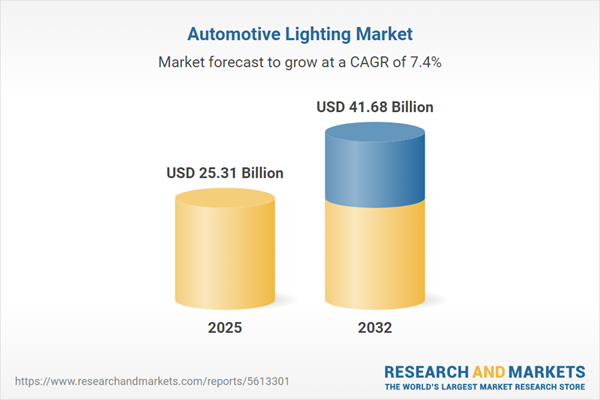Speak directly to the analyst to clarify any post sales queries you may have.
The automotive lighting market is experiencing rapid transformation, driven by technological advancements, evolving regulations, and shifting consumer preferences. Senior decision-makers face a complex landscape where innovation, efficiency, and compliance intersect to shape the competitive environment.
Market Snapshot: Automotive Lighting Market Overview
The automotive lighting market grew from USD 23.60 billion in 2024 to USD 25.31 billion in 2025. It is expected to continue growing at a CAGR of 7.36%, reaching USD 41.68 billion by 2032. This dynamic sector is characterized by the widespread adoption of LED and OLED technologies, propelled by safety regulations, rising demand for customized lighting, and the imperative for enhanced energy efficiency. The industry’s growth reflects both OEM and aftermarket expansion, underpinned by regulatory mandates and consumer-driven design trends.
Scope & Segmentation
- Distribution Channel: OEM, Aftermarket
- Vehicle Type: Heavy Commercial Vehicle, Light Commercial Vehicle (including Pickup, Van), Passenger Car (Hatchback, Compact Sedan, Mid Size Sedan, Compact SUV, Luxury SUV)
- Application: Exterior, Interior (Ambient Lighting with Color Customization and Intensity Control, Dome Lamps, Map Lamps, Courtesy Lamps)
- Technology: Halogen, HID (Plasma, Xenon), Laser, LED (MicroLED, OLED, Flexible OLED, Rigid OLED, Traditional LED)
- Product Type: Daytime Running Lamps (Fiber Optic, LED), Fog Lamps (Halogen, LED), Headlamps (Adaptive Systems such as Adaptive Front Lighting System, Matrix LED, High Beam, Low Beam), Tail Lamps (Conventional, LED)
- Regional Coverage: Americas (United States, Canada, Mexico, Brazil, Argentina, Chile, Colombia, Peru), Europe, Middle East & Africa (United Kingdom, Germany, France, Russia, Italy, Spain, Netherlands, Sweden, Poland, Switzerland, UAE, Saudi Arabia, Qatar, Turkey, Israel, South Africa, Nigeria, Egypt, Kenya), Asia-Pacific (China, India, Japan, Australia, South Korea, Indonesia, Thailand, Malaysia, Singapore, Taiwan)
- Major Companies Profiled: HELLA GmbH & Co. KGaA, Koito Manufacturing Co., Ltd., Valeo S.A., ZKW Group GmbH, Stanley Electric Co., Ltd., Magneti Marelli S.p.A., Signify N.V., ams OSRAM AG, Varroc Lighting Systems Pvt. Ltd., Lumileds LLC
Key Takeaways for Senior Decision-Makers
- Regulatory compliance is a primary catalyst for technological innovation, with major markets enforcing adaptive lighting and safety features, directly shaping product development and corporate investment strategies.
- Personalized lighting experiences are gaining traction, prompting manufacturers to focus on modular systems and design signatures to address the demands of both premium and mainstream vehicle segments.
- Energy efficiency and power-saving measures are integral, as advanced LEDs and smart controls enable lower consumption and operational cost reductions for both OEMs and fleet operators.
- Global supply chain volatility stemming from material costs, tariffs, and semiconductor shortages intensifies the need for flexible sourcing strategies and strategic regional partnerships.
- Cross-functional collaboration between OEMs, component suppliers, and technology partners accelerates the adoption of connected, intelligent lighting solutions and ensures market agility.
Tariff Impact: Navigating the US 2025 Automotive Lighting Tariffs
New tariffs in the United States have increased cost pressures on imported lighting components, requiring strategic adjustments in sourcing and production. Many suppliers are localizing manufacturing or shifting operations to tariff-exempt regions. Short-term shifts in procurement and product portfolios spotlight the need for adaptable manufacturing strategies and bulk purchasing to maintain profitability. These changes encourage innovation in cost-efficient lighting, impacting decisions across OEM, aftermarket, and distribution channels.
Methodology & Data Sources
This report applies a rigorous methodology, combining primary interviews with OEM engineers, R&D leaders, and aftermarket executives with comprehensive secondary research. Industry publications, technical journals, regulatory filings, and trade association benchmarks inform the analysis, ensuring a balanced perspective. Advanced analytics and expert panel reviews validate all insights and unpack the nuanced evolution of the automotive lighting sector.
Why This Report Matters
- Enables leadership teams to anticipate market shifts and make data-driven investments aligned with regulatory and consumer trends.
- Empowers procurement and product managers to navigate uncertainty from tariffs, supply chain changes, and evolving technology standards.
- Guides strategy development with actionable segmentation, competitive intelligence, and coverage of regional nuances critical for global market expansion.
Conclusion
The automotive lighting market stands at the intersection of technology, regulation, and design innovation. Leaders who prioritize flexibility, collaboration, and targeted investment will capture emerging growth and navigate sector complexities with confidence.
Additional Product Information:
- Purchase of this report includes 1 year online access with quarterly updates.
- This report can be updated on request. Please contact our Customer Experience team using the Ask a Question widget on our website.
Table of Contents
3. Executive Summary
4. Market Overview
7. Cumulative Impact of Artificial Intelligence 2025
Companies Mentioned
The companies profiled in this Automotive Lighting market report include:- HELLA GmbH & Co. KGaA
- Koito Manufacturing Co., Ltd.
- Valeo S.A.
- ZKW Group GmbH
- Stanley Electric Co., Ltd.
- Magneti Marelli S.p.A.
- Signify N.V.
- ams OSRAM AG
- Varroc Lighting Systems Pvt. Ltd.
- Lumileds LLC
Table Information
| Report Attribute | Details |
|---|---|
| No. of Pages | 197 |
| Published | October 2025 |
| Forecast Period | 2025 - 2032 |
| Estimated Market Value ( USD | $ 25.31 Billion |
| Forecasted Market Value ( USD | $ 41.68 Billion |
| Compound Annual Growth Rate | 7.3% |
| Regions Covered | Global |
| No. of Companies Mentioned | 11 |









